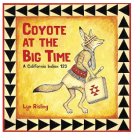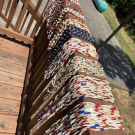California Native Peoples - Counting 1-10
WL.CL2.N: Cultural Products, Practices, and Perspectives, WL.CL4.A: Intercultural Influences, K.CC.1, K.CC.2, K.CC.4.a, K.CC.4.b, K.CC.4.c, K.CC.5In this engaging TK–1 lesson, students are introduced to Coyote at the Big Time, A California Indian 123, a counting book written and illustrated by Karuk/Yurok/Hupa artist, Lyn Risling.

